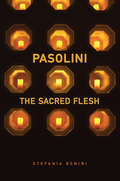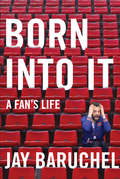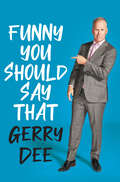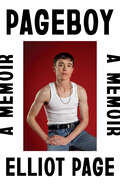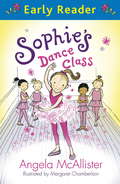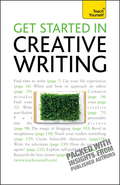- Table View
- List View
Federico Fellini
by Hava AldoubyFederico Fellini professed a desire to create "an entire film made of immobile pictures." In this study, Hava Aldouby uses this quotation as a launching point to analyze Fellini's films as sequences of "pictures" that draw extensively on art history, and particularly painting, as a reservoir of visual imagery. Aldouby employs an innovative pictorial approach that allows her to uncover a wealth of visual evocations overlooked by Fellini scholars over the years.Federico Fellini: Painting in Film, Painting on Film sheds light on the intertextual links between Fellini's films and the works of various artists, from Velazquez to Francis Bacon, by identifying references to specific paintings in his films. Using new archival evidence from Fellini's private library, brought to light for the first time here, Aldouby draws out Fellini's in-depth knowledge of art history and his systematic employment of art-historical allusions.
Pasolini
by Stefania BeniniPoet, novelist, dramatist, polemicist, and filmmaker Pier Paolo Pasolini continues to be one of the most influential intellectuals of post-war Italy. In Pasolini: The Sacred Flesh, Stefania Benini examines his corporeal vision of the sacred, focusing on his immanent interpretation of the Christian doctrine of the Incarnation and the "sacred flesh" of Christ in both Passion and Death as the subproletarian flesh of the outcast at the margins of capitalism.By investigating the many crucifixions within Pasolini's poems, novels, films, cinematic scripts and treatments, as well as his subversive hagiographies of criminal or crazed saints, Benini illuminates the radical politics embedded within Pasolini's adoption of Christian themes. Drawing on the work of theorists such as Ernesto De Martino, Mircea Eliade, Jean-Luc Nancy, Alain Badiou, Giorgio Agamben, and Slavoj Žižek, she shows how Pasolini's meditation on the disappearance of the sacred in our times and its return as a haunting revenant, a threatening disruption of capitalist society, foreshadows current debates on the status of the sacred in our postmodern world.
John Paizs's Crime Wave
by Jonathan BallJohn Paizs's 'Crime Wave' examines the Winnipeg filmmaker's 1985 cult film as an important example of early postmodern cinema and as a significant precursor to subsequent postmodern blockbusters, including the much later Hollywood film Adaptation. Crime Wave's comic plot is simple: aspiring screenwriter Steven Penny, played by Paizs, finds himself able to write only the beginnings and endings of his scripts, but never (as he puts it) "the stuff in-between." Penny is the classic writer suffering from writer's block, but the viewer sees him as the (anti)hero in a film told through stylistic parody of 1940s and 50s B-movies, TV sitcoms, and educational films.In John Paizs's 'Crime Wave,' writer and filmmaker Jonathan Ball offers the first book-length study of this curious Canadian film, which self-consciously establishes itself simultaneously as following, but standing apart from, American cinematic and television conventions. Paizs's own story mirrors that of Steven Penny: both find themselves at once drawn to American culture and wanting to subvert its dominance. Exploring Paizs's postmodern aesthetic and his use of pastiche as a cinematic technique, Ball establishes Crime Wave as an overlooked but important cult classic.
Fluid Screens, Expanded Cinema
by Susan Lord Janine MarchessaultAs a medium, film is constantly evolving both in form and in content. Fluid Screens, Expanded Cinema considers the shift from traditional cinema to new frontiers of interactive, performative, and networked media.Using the theories of Marshall McLuhan and Gilles Deleuze as a starting point, renowned scholars from the fields of film theory, communication studies, cultural studies, and new media theory explore the ways in which digital technology is transforming contemporary visual culture. The essays consider a series of questions: What constitutes the "new" in new media? How are digital aesthetics different from film aesthetics? What new forms of spectatorship and storytelling, political community, and commodity production are being enabled through the digital media?Using Gene Youngblood's 1970 book Expanded Cinema as an anchor for the volume, Fluid Screens, Expanded Cinema understands the digital not simply as a technological form, but also as an experience of space and time that is tied to capitalism. This important collection is unique in framing a range of social justice issues with aesthetic theories of new digital screen culture that will appeal to scholars and multimedia artists prepared to break new ground.
Miracles and Sacrilege
by William Bruce JohnsonMiracles and Sacrilege is the story of the epochal conflict between censorship and freedom in film, recounted through an in-depth analysis of the U.S. Supreme Court?s decision striking down a government ban on Roberto Rossellini?s film The Miracle (1950). In this extraordinary case, the Court ultimately chose to abandon its own longstanding determination that film comprised a mere ?business? unworthy of free-speech rights, declaring for the first time that the First Amendment barred government from banning any film as ?sacreligious.?Using legal briefs, affidavits, and other court records, as well as letters, memoranda, and other archival materials to elucidate what was at issue in the case, William Bruce Johnson also analyzes the social, cultural, and religious elements that form the background of this complex and hard-fought controversy, focusing particularly on the fundamental role played by the Catholic Church in the history of film censorship. Tracing the development of the Church in the United States, Johnson discusses the reasons it found The Miracle sacrilegious and how it attained the power to persuade civil authorities to ban it. The Court?s decision was not only a milestone in the law of church-state relations, but it paved the way for a succession of later decisions which gradually established a firm legal basis for freedom of expression in the arts.
Italian Neorealist Cinema
by Christopher WagstaffThe end of the Second World War saw the emergence of neorealist film in Italy. In Italian Neorealist Cinema, Christopher Wagstaff analyses three neorealist films that have had significant influence on filmmakers around the world. Wagstaff treats these films as assemblies of sounds and images rather than as representations of historical reality. If Roberto Rossellini's Roma città aperta and Paisà, and Vittorio De Sica's Ladri di biciclette are still, half a century after they were made, among the most highly valued artefacts in the history of cinema, Wagstaff suggests that this could be due to the aesthetic and rhetorical qualities of their assembled narratives, performances, locations, lighting, sound, mise en scène, and montage.This volume begins by situating neorealist cinema in its historical, industrial, commercial and cultural context, and makes available for the first time a large amount of data on post-war Italian cinema. Wagstaff offers a theoretical discussion of what it means to treat realist films as aesthetic artefacts before moving on to the core of the book, which consists of three studies of the films under discussion. Italian Neorealist Cinema not only offers readers in Film Studies and Italian Studies a radically new perspective on neorealist cinema and the Italian art cinema that followed it, but theorises and applies a method of close analysis of film texts for those interested in aesthetics and rhetoric, as well as cinema in general.
The Voice of Newfoundland
by Jeff WebbSimilar to the CBC and BBC, the Broadcasting Corporation of Newfoundland was a public broadcaster that was at the centre of a cultural and political change from 1939 to 1949, during which Newfoundland faced wartime challenges and engaged in a constitutional debate about whether to become integrated into Canada. The Voice of Newfoundland studies these changes by taking a close look at the Broadcasting Corporation of Newfoundland's radio programming and the responses of their listeners. Making excellent use of program recordings, scripts, and letters from listeners, as well as government and corporate archives, Jeff A. Webb examines several innovative programs that responded to the challenges of the Great Depression and Second World War. Webb explores the roles that radio played in society and culture during a vibrant and pivotal time in Newfoundland's history, and demonstrates how the broadcaster's decision to air political debates was pivotal in Newfoundlanders's decision to join Canada and to become part of North American consumer society. An engaging study rich in details of some of twentieth-century Newfoundland's most fascinating figures, The Voice of Newfoundland is a remarkable history of its politics and culture and an important analysis of the influence of the media and the participation of listeners.
From Plato to Lumière
by Timothy Barnard Andre GaudreaultWith this lucid translation of Du litteraire au filmique, André Gaudreault's highly influential and original study of film narratology is now accessible to English-language audiences for the first time. Building a theory of narrative on sources as diverse as Plato, The Arabian Nights,and Proust, From Plato to Lumière challenges narratological orthodoxy by positing that all forms of narrative are mediated by an "underlying narrator" who exists between the author and narrative text. Offering illuminating insights, definitions, and formal distinctions, Gaudreault examines the practices of novelists, playwrights, and filmmakers and applies his theory to the early cinema of the Lumière brothers and more recent films. He also enhances our understanding of how narrative develops visually without language - monstration - by detailing how the evolution of the medium influenced narratives in cinema. From Plato to Lumière includes a translation of Paul Ricoeur's preface to the French-language edition as well as a new preface by Tom Gunning. It is a must-read for cinema and media students and scholars and an essential text on the study of narrative.
Denys Arcand's Le Declin de l'empire americain and Les Invasions barbares
by Andrê LoiselleThe release of Denys Arcand's Le Déclin de l'empire américain (The Decline of the American Empire) in 1986 marked a major turning point in Quebec cinema. It was the first Québécois film that enjoyed huge critical and commercial success at home and abroad. Arcand's tragicomedy about eight intellectuals gathered around a dinner table relating sexy anecdotes became the top-grossing film of all time in Quebec and was the first Canadian feature to be nominated for an Oscar in the foreign-language category. Seventeen years later, Arcand won an Academy Award for the sequel, Les Invasions barbares (The Barbarian Invasions), where the amusing insouciance of the thirty-somethings talking dirty in Le Déclin is replaced by a sense of moral responsibility and serene resignation. In this engrossing study, André Loiselle presents the first in-depth analysis of both films within the context of Quebec culture. Through close readings and concise cultural analysis of two of the most important films in the history of Quebec cinema, Loiselle demonstrates the ways in which Arcand's work represents a snapshot of the evolution of the French Canadian film industry since 1980. The companion films trace the decline of Quebec's national dream and the Québécois' attempts to cling to their identity against the forces of barbaric globalization. The second title in the new Canadian Cinema series, Denys Arcand's "Le Déclin de l'empire américain" and "Les Invasions barbares" is essential reading for cinephiles, film critics, and anyone with an interest in cultural studies and Canadian and Quebec history.
Allan King's A Married Couple
by Zoe DruickLong before 'Reality TV,' Canadian filmmaker Allan King caused a stir by mixing people's private and public lives in his 1969 documentary A Married Couple. This observational cinema piece, which took an unscripted look at the urban Edwards family, was deemed too contentious to air by commissioning network CTV on the grounds of excessive nudity and obscenity. Nevertheless, the documentary was accepted by the Cannes festival, and it is now cited as a milestone in realist filmmaking.In Allan King's A Married Couple, Zoë Druick examines the film in the context of late 1960s cinematic and cultural movements. Through a scene-by-scene synopsis and an analysis of contemporary responses to the piece, she traces A Married Couple's influence on documentary and Canadian filmmaking. The fifth volume in the Canadian Cinema series, this work is an accessible and engaging introduction to a controversial film and its fascinating director.
Guy Maddin's My Winnipeg
by Darren WershlerGuy Maddin is Canada's most iconoclastic filmmaker. Through his reinvention of half-forgotten film genres, his remobilization of abandoned techniques from the early history of cinema, and his unique editing style, Maddin has created a critically successful body of work that looks like nothing else in Canadian film. My Winnipeg (2008), which Roger Ebert called one of the ten best films of the first decade of the twenty-first century, has consolidated Maddin's international reputation.In this sixth volume of the Canadian Cinema series, Darren Wershler argues that Maddin's use of techniques and media that fall outside of the normal repertoire of contemporary cinema require us to re-examine what we think we know about the documentary genre and even 'film' itself. Through an exploration of My Winnipeg's major thematic concerns - memory, the cultural archive, and how people and objects circulate through the space of the city - Wershler contends that the result is a film that is psychologically and affectively true without being historically accurate.
Stages of Reality
by Jeremy Maron André LoiselleA groundbreaking collection of original essays, Stages of Reality establishes a new paradigm for understanding the relationship between stage and screen media. This comprehensive volume explores the significance of theatricality within critical discourse about cinema and television.Stages of Reality connects the theory and practice of cinematic theatricality through conceptual analyses and close readings of films including The Matrix and There Will be Blood. Contributors illuminate how this mode of address disrupts expectations surrounding cinematic form and content, evaluating strategies such as ostentatious performances, formal stagings, fragmentary montages, and methods of dialogue delivery and movement. Detailing connections between cinematic artifice and topics such as politics, gender, and genre, Stages of Reality allows readers to develop a clear sense of the multiple purposes and uses of theatricality in film.
Seeing Things
by Alan AckermanA technological revolution has changed the way we see things. The storytelling media employed by Pixar Animation Studios, Samuel Beckett, and William Shakespeare differ greatly, yet these creators share a collective fascination with the nebulous boundary between material objects and our imaginative selves. How do the acts of seeing and believing remain linked? Alan Ackerman charts the dynamic history of interactions between showing and knowing in Seeing Things, a richly interdisciplinary study which illuminates changing modes of perception and modern representational media.Seeing Things demonstrates that the airy nothings of A Midsummer Night's Dream, the Ghost in Hamlet, and soulless bodies in Beckett's media experiments, alongside Toy Story's digitally animated toys, all serve to illustrate the modern problem of visualizing, as Hamlet put it, 'that within which passes show.' Ackerman carefully analyses such ghostly appearances and disappearances across cultural forms and contexts from the early modern period to the present, investigating the tension between our distrust of shadows and our abiding desire to believe in invisible realities. Seeing Things provides a fresh and surprising cultural history through theatrical, verbal, pictorial, and cinematic representations.
Atom Egoyan's 'The Adjuster'
by Tom McsorleyOne of Canada's pre-eminent auteur filmmakers, Atom Egoyan has been celebrated internationally, earning multiple awards from the prestigious Cannes and Toronto Film Festivals and an Academy Award nomination. One of his most accomplished and controversial early works, The Adjuster, is a dark drama about the complex and intense relationship between an insurance adjuster and his clients.In this accessible analysis, Tom McSorley traces the genesis, production, and reception of Egoyan's fourth feature film, from its Cannes Film Festival premiere to its North American commercial release. The book locates The Adjuster in the larger context of Canadian cinema history's peculiar and often troubled evolution, and offers a provocative interpretation of the film's unique analysis of the malaise of materialism in North American culture. Richly illustrated and featuring new interview material with Egoyan himself, this study in the Canadian Cinema series offers an insightful review of one of Atom Egoyan's most searching, unsettling films.
Canadian Cinema Since the 1980s
by David L. PikeAward-winning author David L. Pike offers a unique focus on the crucial quarter-century in Canadian filmmaking when the industry became a viable force on the international stage. Pike provides a lively, personal, and accessible history of the most influential filmmakers and movements of both Anglo-Canadian and Quebecois cinema, from popular movies to art film and everything in between.Along with in-depth studies of key directors, including David Cronenberg, Patricia Rozema and Denys Arcand, Jean-Claude Lauzon, Robert Lepage, Léa Pool, Atom Egoyan, and Guy Maddin, Canadian Cinema since the 1980s reflects on major themes and genres and explores the regional and cultural diversity of the period. Pike positions Canadian filmmaking at the frontlines of a profound cinematic transformation in the age of global media and presents fresh perspectives on both its local and international contexts. Making a significant advance in the study of the film industry of the period, Canadian Cinema since the 1980s is also an ideal text for students, researchers, and Canadian film enthusiasts.
Into the Past
by William BeardGuy Maddin started making films in his back yard and on his kitchen table. Now his unique work, which relies heavily on such archaic means as black and white small-format cinematography and silent-film storytelling, premieres at major film festivals around the world and is avidly discussed in the critical press. Into the Past provides a complete and systematic critical commentary on each of Maddin's feature films and shorts, from his 1986 debut film The Dead Father through to his highly successful 2008 full-length 'docu-fantasia' My Winnipeg.William Beard's extensive analysis of Maddin's narrative and aesthetic strategies, themes, influences, and underlying issues also examines the origins and production history of each film. Each of Maddin's projects and collaborations showcase his gradual evolution as a filmmaker and his singular development of narrative forms. Beard's close readings of these films illuminate, among other things, the profound ways in which Maddin's art is founded in the past - both in the cultural past, and in his personal memory.
Marco Bellocchio
by Clodagh BrookMarco Bellocchio is one of Italy's most important and prolific directors, with a career spanning five decades. In this book, Clodagh J. Brook explores the boundaries between the public and the private, the political and the personal, and the collective and the individual as they appear in Bellocchio's films. Including work on psychoanalysis, politics, film production, autobiography, and the relationship between film tradition and contemporary culture, Marco Bellocchio touches on fundamental issues in film analysis.Brook's study interrogates what it means to make personal or anti-institutional art in a medium dominated by a late-capitalist industrial model of production. Her readings of Bellocchio's often enigmatic and perplexing work suggest new ways to answer questions about subjectivity, objectivity, and political commentary in modes of filmmaking. Relating the art of a private director to a public medium, Clodagh J. Brook's work is an important contribution to our understanding of film.
Joyce Wieland's 'The Far Shore'
by Johanne SloanThe Far Shore (1976), made under the direction of celebrated visual artist and experimental filmmaker Joyce Wieland, is one of Canada's most innovative contributions to cinema. The film borrows elements from the life of Canadian painter Tom Thomson, who is represented by the character of Tom McLeod. The main character, however, is not Tom, but the fictional creation of Eulalie de Chicoutimi, the married Québécoise woman who loves him. Using Eulalie's perspective, Wieland was able to re-frame Thomson's life and story as a romantic melodrama while infusing it with subversive commentary on gender, nature and nationalism, and ultimately, on the value of art.Here, Wieland specialist Johanne Sloan offers a fascinating new perspective on The Far Shore, making it more accessible by discussing Wieland's utopian fusion of art and politics, the importance of landscape within Canadian culture, and the on-going struggle over the meaning of the natural environment.
The Mirage of America in Contemporary Italian Literature and Film
by Barbara AlfanoThe Mirage of America in Contemporary Italian Literature and Film explores the use of images associated with the United States in Italian novels and films released between the 1980s and the 2000s. In this study, Barbara Alfano looks at the ways in which the individuals portrayed in these works - and the intellectuals who created them - confront the cultural construct of the American myth. As Alfano demonstrates, this myth is an integral part of Italians' discourse to define themselves culturally - in essence, Italian intellectuals talk about America often for the purpose of talking about Italy.The book draws attention to the importance of Italian literature and film as explorations of an individual's ethics, and to how these productions allow for functioning across cultures. It thus differentiates itself from other studies on the subject that aim at establishing the relevance and influence of American culture on Italian twentieth-century artistic representations.
Born into It: A Fan's Life
by Jay BaruchelIn Fever Pitch meets Anchor Boy, Montreal Canadiens superfan Jay Baruchel tells us why he loves the Habs no matter whatIt’s no secret that Jay Baruchel is a die-hard fan of the Montreal Canadiens. He talks about the team at every opportunity, wears their gear proudly in interviews and on the street, appeared in a series of videos promoting the team, and was once named honorary captain by owner Geoff Molson and Habs tough guy Chris Nilan. As he has said publicly, “I was raised both Catholic and Jewish, but really more than anything just a Habs fan.”In Born Into It, Baruchel’s lifelong memories as a Canadiens’ fan explode on the page in a collection of hilarious, heartfelt and nostalgic stories that draw on his childhood experiences as a homer living in Montreal and the enemy living in the Maple Leaf stronghold of Oshawa, Ontario. Knuckles drawn, and with the rouge, bleu et blanc emblazoned on just about every piece of clothing he owns, Baruchel shares all in the same spirit with which he laid his soul bare in his hugely popular Goon movies. Born Into It is a memoir unlike any other, and a book not to be missed.
Funny You Should Say That
by Gerry DeeOne of Canada’s top comedians shares the funniest stories from his life and career in this collection of hilarious essaysFor more than two decades, Gerry Dee has made audiences laugh, first as a hard-working stand-up comedian, and then as the star of his own CBC television program, Mr. D. Dee became a physical education teacher, thinking he would have it made: coaching, summers off and a good pension. But he found himself dreaming of a career in comedy, until one day, years later, he turned in his teaching certificate and picked up a microphone. He went on to become one of Canada’s top comics. In his new book of essays, Dee writes about his life—being a kid in suburban Toronto, becoming a father, starring in his own TV show, going on the road to comedy clubs across Canada and the US. He takes us behind the scenes of Last Comic Standing, Mr. D and everywhere in between. There was the time he set up his own DVD-signing appearances, only to have no one show up. Or the time he was flown to the Bahamas, where he performed for drunken fishermen and their “nieces.” And he shares his lifelong affliction with hypochondria and all the medical conditions he doesn’t have. This is Gerry Dee at his comedic finest.
Pageboy: A Memoir
by Elliot PageThe Oscar-nominated star who captivated the world with his performance in Juno finally shares his truth.“Can I kiss you?” It was two months before the world premiere of Juno, and Elliot Page was in his first ever queer bar. The hot summer air hung heavy around him as he looked at her. And then it happened. In front of everyone. A previously unfathomable experience. Here he was on the precipice of discovering himself as a queer person, as a trans person. Getting closer to his desires, his dreams, himself, without the repression he’d carried for so long. But for Elliot, two steps forward had always come with one step back. With Juno’s massive success, Elliot became one of the world’s most beloved actors. His dreams were coming true, but the pressure to perform suffocated him. He was forced to play the part of the glossy young starlet, a role that made his skin crawl, on and off set. The career that had been an escape out of his reality and into a world of imagination was suddenly a nightmare. As he navigated criticism and abuse from some of the most powerful people in Hollywood, a past that snapped at his heels, and a society dead set on forcing him into a binary, Elliot often stayed silent, unsure of what to do, until enough was enough. Full of behind the scenes details and intimate interrogations on sex, love, trauma, and Hollywood, Pageboy is the story of a life pushed to the brink. But at its core, this beautifully written, winding journey of what it means to untangle ourselves from the expectations of others is an ode to stepping into who we truly are with defiance, strength, and joy.
Sophie's Dance Class
by Angela McAllister Margaret ChamberlainEarly Readers are stepping stones from picture books to reading books. A blue Early Reader is perfect for sharing and reading together. A red Early Reader is the next step on your reading journey.Sophie loves to dance. She dreams of being a ballerina, and when she receives ballet lessons for her birthday, she hopes her wish to be a real dancer one day might really come true.
Sophie's Dance Class (Early Reader)
by Angela McAllisterEarly Readers are stepping stones from picture books to reading books. A blue Early Reader is perfect for sharing and reading together. A red Early Reader is the next step on your reading journey.Sophie loves to dance. She dreams of being a ballerina, and when she receives ballet lessons for her birthday, she hopes her wish to be a real dancer one day might really come true.
Get Started In Creative Writing: Teach Yourself (Ty Creative Writing Ser.)
by Stephen MayGet Started in Creative Writing is an indispensible guide to unlocking your creativity, finding your voice and choosing a genre of writing that suits you best, whether fiction or non-fiction, short stories or novels, children's books or travel writing. It features guidelines for do's and don'ts along with suggestions for crafting a distinctive style.With tips from some of the best-known writers of fiction and non-fiction, you will receive loads of helpful advice to enable you get your own work published.NOT GOT MUCH TIME?One, five and ten-minute introductions to key principles to get you started.AUTHOR INSIGHTSLots of instant help with common problems and quick tips for success, based on the author's many years of experience.TEST YOURSELFTests in the book and online to keep track of your progress.EXTEND YOUR KNOWLEDGEExtra online articles at www.teachyourself.com to give you a richer understanding of creative writing.FIVE THINGS TO REMEMBERQuick refreshers to help you remember the key facts.TRY THISInnovative exercises illustrate what you've learnt and how to use it.

